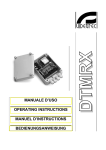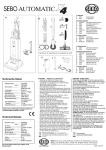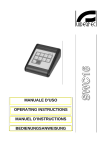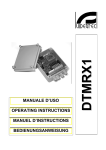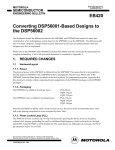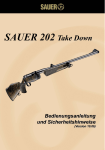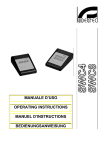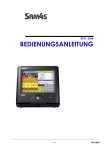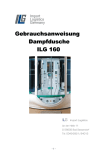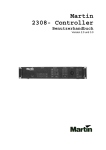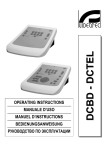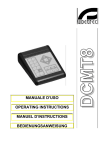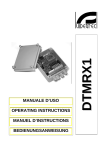Download manuale d'uso - webclienti.it
Transcript
MANUALE D’USO ____________________________ OPERATING INSTRUCTIONS ____________________________ MANUEL D’INSTRUCTIONS ____________________________ BEDIENUNGSANWEISUNG MANUALE D’USO INDICE INDICE.................................................................................................................................................................................... 1 INTRODUZIONE .................................................................................................................................................................... 2 Contenuto dell’imballo ............................................................................................................................................................................... 2 Cosa contiene questo manuale................................................................................................................................................................. 2 Convenzioni tipografiche ........................................................................................................................................................................... 2 NORME DI SICUREZZA ........................................................................................................................................................ 2 DATI DI MARCATURA........................................................................................................................................................... 3 DESCRIZIONE DEL RICEVITORE MICRODEC ................................................................................................................... 3 Caratteristiche ........................................................................................................................................................................................... 3 Apparecchi compatibili per l’uso con il ricevitore MICRODEC .................................................................................................................. 3 INSTALLAZIONE ................................................................................................................................................................... 3 Apertura dell’imballaggio ........................................................................................................................................................................... 3 Controllo della marcatura .......................................................................................................................................................................... 4 Dip-switch di configurazione...................................................................................................................................................................... 4 Impostazione del numero di identificazione del ricevitore ......................................................................................................................... 4 Impostazione della velocità di comunicazione .......................................................................................................................................... 4 FASI PER IL MONTAGGIO DEL MICRODEC ...................................................................................................................... 5 Collegamento dei cavi del brandeggio, delle ottiche del canale di comunicazione e dell’alimentazione .................................................. 6 Cavi ........................................................................................................................................................................................................... 6 Esempio di installazione............................................................................................................................................................................ 7 ACCENSIONE........................................................................................................................................................................ 8 MANUTENZIONE................................................................................................................................................................... 8 LED DI DIAGNOSTICA MICRODEC ..................................................................................................................................... 8 RISOLUZIONE DI PROBLEMI .............................................................................................................................................. 8 Il produttore declina ogni responsabilità per eventuali danni derivanti da un uso improprio delle apparecchiature menzionate in questo manuale; si riserva inoltre il diritto di modificarne il contenuto senza preavviso. Ogni cura é stata posta nella raccolta e nella verifica della documentazione contenuta in questo manuale: tuttavia il produttore non può assumersi alcuna responsabilità derivante dall’utilizzo della stessa. Lo stesso dicasi per ogni persona o società coinvolta nella creazione e nella produzione di questo manuale. Pag. 1 MICRODEC9829 Introduzione Contenuto dell’imballo • 1 ricevitore MICRODEC • 1 piastra di sostegno • 4 distanziali • 2 viti di fissaggio • 1 manuale d’uso Alla consegna del prodotto verificare che l’imballo sia integro e non abbia segni evidenti di cadute o abrasioni. In caso di evidenti segni di danno all’imballo contattare immediatamente il fornitore. Controllare che il contenuto sia rispondente alla lista del materiale sopra indicata. Cosa contiene questo manuale In questo manuale è descritto il ricevitore MICRODEC, con le particolari procedure di installazione, configurazione e utilizzo. E’ necessario leggere attentamente questo manuale, in particolar modo il capitolo concernente le norme di sicurezza, prima di installare ed utilizzare il ricevitore. Convenzioni tipografiche Nel presente manuale si fa uso di diversi simboli grafici, il cui significato è riassunto di seguito: Rischio di scariche elettriche; togliere l’alimentazione prima di procedere con le operazioni, se non é espressamente indicato il contrario. L’operazione é molto importante per il corretto funzionamento del sistema: si prega di leggere attentamente la procedura indicata, ed eseguirla secondo le modalità previste. Descrizione delle caratteristiche del sistema: si consiglia di leggere attentamente per comprendere le fasi successive. Norme di sicurezza Il ricevitore MICRODEC é conforme alle normative vigenti all’atto della pubblicazione del presente manuale per quanto concerne la sicurezza elettrica, la compatibilità elettromagnetica ed i requisiti generali. Si desidera tuttavia garantire gli utilizzatori (tecnico installatore e operatore) specificando alcune avvertenze per operare nella massima sicurezza: • Collegare ad una linea di alimentazione corrispondente a quella indicata sulle etichette di marcatura (vedere il successivo capitolo Dati di marcatura) • La presa di alimentazione deve essere connessa a terra secondo le norme vigenti • Prima di spostare o effettuare interventi tecnici sull’apparecchio, disinserire la spina di alimentazione • Non utilizzare cavi di tensione con segni di usura o invecchiamento, in quanto rappresentano un grave pericolo per l’incolumità degli utilizzatori • L’installazione dell’apparecchio (e dell’intero impianto di cui esso fa parte) deve essere effettuata da personale tecnico adeguatamente qualificato • L’apparecchio deve essere aperto soltanto da personale tecnico qualificato. La manomissione dell’apparecchio fa decadere i termini di garanzia • Non utilizzare l’apparecchio in presenza di sostanze infiammabili • Non permettere l’uso dell’apparecchio a bambini o incapaci • Accertarsi che l’apparecchio sia fissato in maniera solida e affidabile • L’apparecchio si considera disattivato soltanto quando l’alimentazione é disinserita e i cavi di collegamento con altri dispositivi sono stati rimossi • Per l’assistenza tecnica rivolgersi esclusivamente al personale tecnico autorizzato • Conservare con cura il presente manuale per ogni futura consultazione Pag. 2 MICRODEC9829 Dati di marcatura Sulla scatola del ricevitore MICRODEC sono riportate due etichette conformi alla marcatura CE. La prima etichetta contiene: • Codice di identificazione del modello (Codice a barre Extended 3/9 ) • Tensione di alimentazione (Volt) • Frequenza (Hertz) • Consumo (Watt) La seconda etichetta indica il numero di serie del modello (codice a barre Extended 3/9) All’atto dell’installazione controllare se le caratteristiche di alimentazione del ricevitore corrispondono a quelle richieste. L’uso di apparecchi non idonei può portare a gravi pericoli per la sicurezza del personale e dell’impianto. Descrizione del ricevitore MICRODEC Il ricevitore MICRODEC è un ricevitore di comandi a microprocessore per il controllo remoto di brandeggi in 24V~ e ottiche motorizzate ad inversione di polarità. Caratteristiche • • • • • • • • • • 8 Funzioni UP, DOWN, LEFT, RIGHT, ZOOM TELE, ZOOM WIDE, FOCUS NEAR, FOCUS FAR. 32 indirizzi selezionabili tramite Dip switch Inserimento diretto nelle custodie HEG, HEB, HEC Ingresso seriale Current Loop (1200/9600 Baud) Logica digitale e parte di potenza optoisolate 2 led di diagnostica Tensione di alimentazione: 24V~ 50/60 Hz Tensione brandeggio: 24V~ 50/60 Hz Tensione ottica: 12V= 50mA (inversione di polarità) Consumo ricevitore: 1 W Apparecchi compatibili per l’uso con il ricevitore MICRODEC • DCS2, DCMT8: tastiere di controllo. • controllore di comunicazioni DCMX: permette di controllare uno o più ricevitori da parte di più tastiere (fino a 4). Fare riferimento ai singoli manuali d’uso per una descrizione completa delle caratteristiche degli apparecchi. Installazione La fase di installazione deve essere effettuata solo da personale tecnico qualificato. Le seguenti procedure sono da effettuare in assenza di alimentazione, se non diversamente indicato. Apertura dell’imballaggio Se l’imballo non presenta evidenti difetti (dovuti a cadute o abrasioni anomale), procedere al controllo del materiale in esso contenuto, secondo la lista fornita al paragrafo Contenuto dell’imballo al capitolo Introduzione. I materiali d’imballo sono costituiti interamente da materiale riciclabile. Sarà cura del tecnico installatore smaltirli secondo le modalità di raccolta differenziata o comunque secondo le norme vigenti nel Paese di utilizzo. Pag. 3 MICRODEC9829 Controllo della marcatura Prima di procedere con l’installazione controllare se il materiale fornito corrisponde alle specifiche richieste, esaminando le etichette di marcatura, secondo quanto descritto al capitolo Descrizione della marcatura. Non effettuare per nessun motivo alterazioni o collegamenti non previsti in questo manuale: l’uso di apparecchi non idonei può portare a gravi pericoli per la sicurezza del personale e dell’impianto. Dip-switch di configurazione La fase di configurazione del ricevitore consente di predisporlo ad un funzionamento ottimale, in base alle necessità dell’impianto. La configurazione deve essere fatta solo al momento dell’installazione da parte del tecnico installatore. I parametri impostati in fase di configurazione sono: • Numero di identificazione del ricevitore • Velocità di comunicazione (baudrate) Dip-switch di configurazione Impostazione del numero di identificazione del ricevitore - assicurarsi che non sia presente l’alimentazione - configurare il dip-switch SW1 secondo la tabella seguente: DIP-SWITCH 01 02 03 04 05 06 07 08 09 10 11 12 13 14 15 16 12345 +----+--++----+-+-+--++-+++----++--+-+-+++-+--+++-++-+++++++----+ DIP-SWITCH 17 18 19 20 21 22 23 24 25 26 27 28 29 30 31 32 12345 +---+ -+--+ ++--+ --+-+ +-+-+ -++-+ +++-+ ---++ +--++ -+-++ ++-++ --+++ +-+++ -++++ +++++ ----- Impostazione della velocità di comunicazione - assicurarsi che non sia presente l’alimentazione - configurare il dip switch SW1 secondo lo schema seguente: dip swich 6: OFF 9600 baud ON 1200 baud Pag. 4 MICRODEC9829 FASI PER IL MONTAGGIO DEL MICRODEC (2) (3) (1) (4) (5) FIG. 1 (1) (2) (3) (4) (5) fondo della custodia piastra di sostegno viti di fissaggio MICRODEC distanziali di fissaggio INSTALLAZIONE Fissare la piastra di sostegno (2) al fondo della custodia (1) tramite le viti (3). Inserire il MICRODEC (4) alla piastra tamite i distanziali (5), esercitando una leggera pressione (FIG. 2). FIG. 2 Pag. 5 MICRODEC9829 Collegamento dei cavi del brandeggio, delle ottiche del canale di comunicazione e dell’alimentazione ATTENZIONE: Prima di effettuare le seguenti operazioni assicurarsi che la tensione di controllo del brandeggio e che le ottiche utilizzate siano di tipo “a inversione di polarità” - Effettuare i collegamenti con ottica e brandeggio secondo le diciture riportate sulla morsettiera - Effettuare i collegamenti dei cavi per l’alimentazione a 24V~ secondo le diciture riportate sulla morsettiera - Effettuare i collegamenti dei cavi per la ricezione dati secondo le diciture riportate sulla morsettiera e lo schema sotto riportato: Collegamento Current Loop: distanza max 1500 metri DCS2/ DCMT8 TX CL Giallo GND CL Rosso ------------- MICRODEC RX CL GND CL Cavi Negli schemi d’esempio sono stati utilizzati di versi tipi di tratto per indicare cavi di diversa funzione: cavo video: coassiale RG 59 o cavo equivalente. cavo multipolare: ogni funzione di controllo del brandeggio viene attivata / disattivata da un relè interno al ricevitore. Stabilire il numero finale di cavi, seguendo le indicazioni seguenti: 5 fili per la movimentazione del brandeggio: destra, sinistra, alto, basso,comune 4 fili di controllo per ottiche ad inversione di polarità (zoom, focus) Nota: è consigliato l’utilizzo di differenti cavi multipolari per le funzioni in bassa tensione ed in alta tensione. Sezione minima consigliata: 0,56 mm.² (AWG 20) per fili in alta tensione (brandeggio) 0,34 mm.² (AWG 22) per fili in bassa tensione (ottica, ausiliare) cavo per la ricezione/trasmissione digitale dei comandi: 2 fili per la ricezione dall’unità di comando (doppino telefonico twistato, sezione 0,22 mm.² AWG 24) non schermato Nota: la distanza massima del collegamento é di circa 1500 m in Current Loop. Pag. 6 MICRODEC9829 Esempio di installazione Un operatore con più monitor, con controllo di una serie di brandeggi in configurazione a stella. MICRODEC MICRODEC MICRODEC MICRODEC DCMX MATERIALE Parte di controllo: 1 tastiera di controllo DCMT8 Parte video: 1 commutatore video SW42REM 2 monitor 4 telecamere Parte telemetria: 1 controllore di comunicazioni DCMX 4 ricevitori MICRODEC 4 brandeggi SW42REM DCMT8 Tre operatori con un monitor ciascuno, con controllo di un gruppo di ricevitori da parte di due di loro; il terzo effettua soltanto operazioni di commutazione video MICRODEC MICRODEC MATERIALE Parte di controllo: 2 tastiere di controllo DCS2 1 tastiera di controllo KEYPLUS Parte video: 3 monitor 3 telecamere Parte telemetria: 3 ricevitori MICRODEC 3 brandeggi 1 controllore di comunicazioni DCMX MICRODEC SW164OSM DCMX DCS2 DCS2 KEYPLUS Pag. 7 MICRODEC9829 Accensione Prima di fornire alimentazione: • controllare se il materiale fornito corrisponde alle specifiche richieste, esaminando le etichette di marcatura, secondo quanto descritto al capitolo Descrizione della marcatura. • controllare che i componenti dell’impianto siano chiusi e sia quindi impossibile il contatto diretto con parti in tensione. • accertarsi che tutte le parti siano fissate in maniera solida ed affidabile • i cavi di alimentazione non devono essere d’intralcio alle normali operazioni del tecnico installatore ed al movimento del brandeggio • controllare che le fonti di alimentazione ed i cavi di collegamento siano in grado di sopportare il consumo del sistema • verificare di aver fornito alimentazione corretta al MICRODEC(24V~) e agli altri componenti installati. Manutenzione Il ricevitore MICRODEC non necessita di particolare manutenzione. Si raccomanda di utilizzarlo in modo tale che i cavi di alimentazione e di collegamento non possano essere causa di intralcio all’operatore. Led di diagnostica MICRODEC Due led (LL1 e LL2) consentono di verificare il corretto funzionamento del MICRODEC. All’accensione entrambi lampeggiano velocemente per circa 1 secondo. Durante il funzionamento normale LL2 lampeggia con periodo di un secondo. LL1 lampeggia brevemente alla ricezione di un comando. Risoluzione di problemi Il ricevitore MICRODEC è caratterizzato da una notevole facilità d’uso, ma ciononostante possono insorgere dei problemi sia in fase di installazione, di configurazione o durante l’uso. Il led LL2 non lampeggia Il brandeggio non funziona L’ottica non funziona Il led LL1 non lampeggia alla ricezione di un comando Il led LL1 lampeggia ma il comando non viene eseguito Manca l’alimentazione Alimentazione del brandeggio errata Controllare il cavo di alimentazione Controllare la tensione di alimentazione del brandeggio L’ottica deve essere di tipo “ad Controllare le caratteristiche dell’ottica inversione di polarità” con tensione di alimentazione di 12V= Linea seriale interrotta Baud rate errato Numero di identificazione errato Pag. 8 Controllare il cavo di collegamento Verificare il corretto inserimento del cavo nei morsetti RXDCL e GND Verificare il dip switch SW1 Impostare il numero corretto sul dip switch SW1 MICRODEC9829 OPERATING INSTRUCTIONS TABLE OF CONTENTS TABLE OF CONTENTS......................................................................................................................................................... 1 INTRODUCTION .................................................................................................................................................................... 2 Contents of the packaging......................................................................................................................................................................... 2 Contents of this manual............................................................................................................................................................................. 2 Typographical conventions........................................................................................................................................................................ 2 SAFETY RULES .................................................................................................................................................................... 2 OPERATING DATA ON THE RATING PLATE ..................................................................................................................... 3 DESCRIPTION OF THE MICRODEC RECEIVER................................................................................................................. 3 Features .................................................................................................................................................................................................... 3 Compatible devices ................................................................................................................................................................................... 3 INSTALLATION ..................................................................................................................................................................... 3 Unpacking ................................................................................................................................................................................................. 3 Control of the operating data on the rating plate ....................................................................................................................................... 4 Dip-switches configuration ........................................................................................................................................................................ 4 Setting the receiver identification number ................................................................................................................................................. 4 Setting the communication speed ............................................................................................................................................................. 4 MICRODEC INSTALLATION STAGES ................................................................................................................................. 5 Connection of the Pan & Tilt motor cables, of the communication channel zoom lenses and of the power supply .................................. 6 Cables ....................................................................................................................................................................................................... 6 Installation examples................................................................................................................................................................................. 7 SWITCHING ON AND SWITCHING OFF .............................................................................................................................. 8 MAINTENANCE ..................................................................................................................................................................... 8 LED DI DIAGNOSTICA MICRODEC ..................................................................................................................................... 8 TROUBLESHOOTING ........................................................................................................................................................... 8 The manufacturer assumes no responsability for possible damages resulting from an improper use of the devices mentioned in this manual; moreover he reserves the right to change the contents of the present manual without notice. The documentation contained in this manual has been gathered and examined with great care; nevertheless the manufacturer can not assume any responsability resulting from the use of such documentation. The same is valid for any other person or society involved in the creation and in the production of the present manual. Page 1 MICRODEC9829 Introduction Contents of the packaging • 1 MICRODEC receiver • 4 wall mounts with relevant fastening screws • 2 PG11 blanking caps • 1 instruction manual On delivery, please make sure that the packaging does not present damages or evident signs of falls or scratches. In case of evident damages, contact immediately the supplier. Please, make sure that the contents correspond to the components list mentioned above. Contents of this manual This manual contains the description of the MICRODEC receiver, with the relevant installation, configuration and use procedures. Before installing and using the receiver it is necessary to read carefully the present manual, in particular the section concerning the safety rules. Typographical conventions The following section illustrates the meaning of graphic symbols used in the present manual: Risk of electric shock; before proceeding with the operations, if not otherwise stated, disconnect the unit. The operation is very important for the correct functioning of the system: please read carefully the procedure indicated and carry it out according to the prescribed specifications. Description of the system features; we recommend reading carefully the sections marked with this symbol in order to understand the phases which follow. Safety rules The MICRODEC receiver complies with the rules in force at the time of publication of the present manual as regards the electric safety, the electromagnetic compatibility and the other general requirements. Nevertheless we would like to assure the users (installer and operator) illustrating some measures to be adopted in order to guarantee the maximum safety: • Connect the unit to a power supply corresponding to the one indicated on the rating plate (see next section Operating data on the rating plate) • The outlet must be adequatly grounded according to the rules in force • Before moving or carrying out technical operations on the unit, disconnect it • Do not use worn or damaged power cords, since they represent a serious risk for the user’s safety • The installation of the unit (and of the whole plant of which this unit is part) must be carried out by adequately skilled technical personnel • The unit must be opened only by skilled technical personnel. The warranty limits does not cover damages resulting from an improper use of the unit • Do not use the device in areas containing inflammable substances • Do not allow children or unskilled persons to use the unit • Make sure that the unit is fixed securely and firmly • The unit is considered off-line only when the power supply is disconnected and the cables aimed to connect the unit with other devices have been removed • For the after-sales service, please contact exclusively the authorized technical personnel • Keep the present manual with care for any future consultation Page 2 MICRODEC9829 Operating data on the rating plate The MICRODEC receiver is supplied with two rating plates in conformity with the EC standards. The first plate contains: • Model identification code (Extended 3/9 bar code) • Power supply (Volt) • Frequency (Hertz) • Power consumption (Watt) The second label indicates the serial number of the model (Extended 3/9 bar code). During the installation phase, make sure that the power supply features of the receiver correspond to the characteristics required. The use of unsuitable devices can lead to serious risks for the safety of the personnel and the security of the plant. Description of the MICRODEC receiver MICRODEC is a microprocessor controlled receiver for the remote control of 24V~ Pan & Tilt motors and of motor zoom lenses of polarity inversion. Features • • • • • • • • • • 8 Functions: UP, DOWN, LEFT, RIGHT, ZOOM TELE, ZOOM WIDE, FOCUS NEAR, FOCUS FAR. 32 identification addresses, selectable by Dip switch Direct installation in HEG, HEB, HEC housings Current Loop serial input (1200/9600 Baud) Opto-insulated digital logic and power part 2 diagnostic leds Power supply: 24 V~ 50/60Hz Pan & Tilt Power supplied: 24V~ 50/60Hz Lens tension: 12V= 50mA (polarity inversion) Receiver consumption: 1W Compatible devices • DCS2, DCMT8: control keyboards. • communication controller DCMX: it allows the operator to control up to 8 line of receivers by means of up yo 4 control keyboards Please refer to each user’s manual for a complete description of the features of the single units. Installation The unit must be installed exclusively by skilled technical personnel. Before carrying out the following operations, if not otherwise stated, always disconnect the unit from power supply. Unpacking If the packaging does not present evident faults (due to falls or anomalous scratches), make sure that its contents correspond to the list of items contained in paragraph Contents of the packaging, in section Introduction. The installer will take care to dispose it according to the recycling programs or, in any case, according to the rules in force in the country of destination. Page 3 MICRODEC9829 Control of the operating data on the rating plate Before installing the unit, control if the goods supplied correspond to the required specifications by examining the rating plates, according to the section Operating data on the rating plate. Never make alterations or connections not provided for in the present manual: the use of unsuitable devices can lead to serious risks for the safety of the personnel and the security of the plant. Dip-switches configuration The configuration phase predisposes the receiver to optimal running, according to system requirements. Before installation please set: • Receiver identification number • Communication speed (baudrate) Configuration dip-switch Setting the receiver identification number - make sure you have cut off the power supply - configure the dip-switch according to the following table: DIP-SWITCH 01 02 03 04 05 06 07 08 09 10 11 12 13 14 15 16 12345 +----+--++----+-+-+--++-+++----++--+-+-+++-+--+++-++-+++++++----+ DIP-SWITCH 17 18 19 20 21 22 23 24 25 26 27 28 29 30 31 32 12345 +---+ -+--+ ++--+ --+-+ +-+-+ -++-+ +++-+ ---++ +--++ -+-++ ++-++ --+++ +-+++ -++++ +++++ ----- Setting the communication speed - make sure you have cut off the power supply - configure the dip-switch SW1 according to the following table: dip swich 6: OFF 9600 baud ON 1200 baud Page 4 MICRODEC9829 MICRODEC INSTALLATION STAGES (2) (3) (1) (4) (5) FIG. 1 (1) (2) (3) (4) (5) housing bottom support plate fastening screws MICRODEC fastening spacers INSTALLATION Fasten the support plate (2) to the housing bottom (1) by the fastening screws (3). Push the MICRODEC (4) on the fastening spacers (5), fixing it to the plate (FIG.2). FIG. 2 Page 5 MICRODEC9829 Connection of the Pan & Tilt motor cables, of the communication channel zoom lenses and of the power supply ATTENTION: Before carrying out the following operations, make sure that the control tension of the Pan & Tilt motor and the zoom lenses used are of “polarity inversion” type. - Connect the zoom lens and the Pan & Tilt motor according to the indications on the terminal board - Connect the cables for 24V~ power supèply according to the indications on the terminal block - Connect the cables for data reception according to the indications on the following scheme: Connection Current Loop: max distance 1500 m. DCS2/ DCMT8 TX CL Yellow GND CL Red ------------- MICRODEC RX CL GND CL Cables In the example schemes, different lines have been used to show different types of functions: video cable: coaxial RG 59 or equivalent cable. multipolar cable: each Pan & Tilt function is enabled/desabled by a relay inside the receiver. Define the cable final number, following these directions: 5 wires for Pan & Tilt movement: right, left, high, up, low, common 4 control wires for polarity inversion zoom lenses (zoom, focus) Note: We recommend the use of different multipolar cables for high tension and low tension functions. Minimum section area recommended: 0.56 mm.² (AWG 20) for high tension wires (Pan & Tilt) 0.34 mm.² (AWG 22) for low tension wires (zoom, lens, auxiliary) cable for control digital reception/transmission: 2 wires for the control unit reception (twisted pair cable, section 0,22 mm² AWG 24) shieldless Note: the maximum connection distance is about 1500 in Current Loop. Page 6 MICRODEC9829 Installation examples Example no.1: a single operator with two monitors, controlling a set of receivers in star configuration MICRODEC MICRODEC MICRODEC MICRODEC DCMX DEVICES Control section: 1 DCMT8 control keyboard Video section: 1 SW42REM video switcher 2 monitors 4 cameras Telemetry section: 1 DCMXserial data multiplexer 4 MICRODEC receivers 4 positioning devices SW42REM DCMT8 Example no.3: three operators with a monitor for each one; two of them control a set of receivers; the third carries out only video switching operations. MICRODEC MICRODEC DEVICES Control section: 2 DCS2 control keyboards 1 KEYPLUS control keyboard Video section: 3 monitors 3 cameras Telemetry section: 3 MICRODEC receivers 3 Pan & Tilt 1DCMX serial data multiplexer MICRODEC SW164OSM DCMX DCS2 DCS2 KEYPLUS Page 7 MICRODEC9829 Switching on and switching off Before connecting the unit: • make sure that the goods supplied correspond to the required specifications by controlling the rating plates, according to the section Operating data on the rating plate. • make sure that the fuses of the MICRODEC receiver are not damaged. • make sure that the receiver and the other components of the plant are closed in order to avoid the direct contact with live elements. • make sure that all parts are accurately and firmly fixed. • the power cords must not hamper the normal operations of the installer and the movement of the positioning device. • check you have correctly fed theMICRODEC (24V~) and the other components installed. Maintenance The MICRODEC receiver does not require special maintenance operations. We recommend placing it on a solid base, with the power cords and the connecting cables positioned such that they are not likely to hamper the operator. Led di diagnostica MICRODEC Two leds (LL1 and LL2) allow checking the correct running of the MICRODEC. On switching on, both will rapidly blink for about 1 second. During normal function, LL2 blinks whit a period of 1 second. LL1 blinks shortly when a command is received. Troubleshooting Although the MICRODEC receiver is characterized by a great ease of use, sometimes troubles may occur, especially during the installation and configuration phases or using the unit. The led LL2 does not blink The Pan & Tilt motor does not run The zoom lens does not run The led LL1 does not blink when receiving a control The led LL1 blinks when receiving a command but no action is performed Power supply not connected The Pan & Tilt power supply is wrong Check the power supply cable Check the Pan & Tilt power supply The zoom lens must be of “polarity inversion” type with 12V = power supply Serial line interrupted Check the zoom lens features Incorrect baud rate The receiver identification number is wrong Page 8 Check the connection cable Check that the cables is cut in the right terminals RXDCL and GND Check the dip switch SW1 Set the right number on the dip switch SW1 MICRODEC9829 MANUEL D’INSTRUCTIONS INDEX INDEX..................................................................................................................................................................................... 1 INTRODUCTION .................................................................................................................................................................... 2 Contenu de l’emballage............................................................................................................................................................................. 2 Contenu du manuel ................................................................................................................................................................................... 2 Conventions typographiques ..................................................................................................................................................................... 2 NORMES DE SÉCURITÉ....................................................................................................................................................... 2 CARACTÉRISTIQUES TECHNIQUES .................................................................................................................................. 3 DESCRIPTION DU RÉCEPTEUR MICRODEC..................................................................................................................... 3 Caractéristiques ........................................................................................................................................................................................ 3 Appareils compatibles pour emploi avec le récepteur MICRODEC .......................................................................................................... 3 INSTALLATION ..................................................................................................................................................................... 3 Déballage .................................................................................................................................................................................................. 3 Contrôle des caractéristiques techniques ................................................................................................................................................. 4 Dip-switch de configuration ....................................................................................................................................................................... 4 Introduction du numéro d’identification du récepteur ................................................................................................................................ 4 Introduction de la vitesse de communication ............................................................................................................................................ 4 PHASES DU MONTAGE DU MICRODEC ............................................................................................................................ 5 Raccordement des câbles de la tourelle, des objectifs du canl de communication et de l’alimentaion .................................................... 6 Câbles ....................................................................................................................................................................................................... 6 Exemples d’installations ............................................................................................................................................................................ 7 ALLUMAGE ET COUPURE................................................................................................................................................... 8 ENTRETIEN ........................................................................................................................................................................... 8 LEDS DE DIAGNOSTIC DU MICRODEC.............................................................................................................................. 8 RÉSOLUTION DE PROBLÈMES .......................................................................................................................................... 8 Le producteur décline toute resposabilité pour éventuels dommages dus à une utilisation non appropriée des appareils mentionnés dans ce manuel; on réserve en outre le droit d’en modifier le contenu sans préavis. La documentation contenue dans ce manuel a été rassemblée et vérifiée avec le plus grand soin: cependant, le producteur ne peut pas s’assumer aucune responsabilité dérivante de l’emploi de celle-là. La même chose vaut pour chaque personne ou société impliquées dans la création et la production de ce manuel. Pag. 1 MICRODEC9829 Introduction Contenu de l’emballage • 1 récepteur MICRODEC • 1 plaque de support • 4 entretoises • 2 vis de fixation • 1 manuel d’emploi Lors de la livraison du produit, vérifier si l’emballage est complet et s’il na pas oubi de détériorations pendant le transport. Si l’emballage présente des signes évidents de dommage, contacter immédiatement le fournisseur. Vérifier que le contenu correspond à la liste du matérel indiquée ci-dessus. Contenu du manuel Dans ce manuel on décrit le récepteur MICRODEC et les procédures particulières d’installation, configuration et emploi. Il est nécessaire de lire attentivement ce manuel, surtout le chapitre concernant les normes de sécurité, avant d’installer et employer le récepteur. Conventions typographiques Dans ce manuel on emploie des symboles graphiques différents, dont le sens est résumé ci-dessous: Risque de décharge électrique; couper l’alimentation avant de procéder à toute opération, si le contraire n’est pas expressément indiqué. L’opération est très importante pour le fonctionnement correct du système: lire attentivement la procédure indiquée, et l’exécuter suivant les modalités prévues. Description des caractéristiques du système: lire attentivement pour comprendre les phases suivantes. Normes de sécurité Le récepteur MICRODEC est conforme aux normes en vigueur au moment de la publication de ce manuel pour ce qui concerne la sécurité électrique, la compatibilité électromagnétique et les conditions requises générales. On désire toutefois garantir les utilisateurs (technicien installateur et opérateur) en précisant certaines instructions pour opérer en toute sécurité: • Raccorder à un feeder suivant les indications des plaques des caractéristiques techniques (voir le chapitre suivant Caractéristiques techniques) • La prise d’alimentation doit être raccordée à la terre conformément aux normes en vigueur • Avant de déplacer ou effectuer des interventions techniques sur l’appareil, débrancher la prise d’alimentation • Ne pas employer de câbles de tension avec signes d’usure ou vieillissement, parce qu’ils peuvent compromettre sérieusement la sécurité des utilisateurs • L’installation de l’appareil (et du système complet dont il fait partie) doit être effectuée par une personne qualifiée du point de vue téchnique • L’appareil doit être ouvert seulement par techniciens qualifiés. L’altération de l’appareil fait déchoir les termes de garantie • Ne pas employer l’appareil en présence de substances inflammables • Ne pas laisser que des enfants ou des personnes incapables utilisent l’appareil • Vérifier si l’appareil est fixé de façon solide et fiable • L’appareil est désactivé seulement quand l’alimentation est débranchée et les câbles de raccordement avec d’autres dispositifs ont été enlevés • Pour le service après-vente s’adresser exclusivement au personnel technique autorisé • Conserver soigneusement ce manuel pour toute consultation ultérieure Pag. 2 MICRODEC9829 Caractéristiques techniques Sur le récepteur MICRODEC il y a deux plaques conformes aux caractéristiques techniques CE. La première plaque contient: • Code d’identification du modèle (Code à barre Extended 3/9 ) • Tension d’alimentation (Volt) • Fréquence (Hertz) • Consommation (Watt) La deuxième plaque indique le numéro de série du modèle (code à barre Extended 3/9) Lors de l’installation vérifier si les caractéristiques d’alimentation du récepteur correspondent aux caractéristiques requises. L’emploi d’appareils non appropriés peut compromettre sérieusement la sécurité du personnel et de l’installation. Description du récepteur MICRODEC Le MICRODEC est un récepteur de commandes à microprocesseur pour le contrôle à distance de tourelles 24V~ et objectifs motorisés à inversion de polarité. Caractéristiques • • • • • • • • • • 8 Fonctions: Haut, Bas, Gauche, Droite, ZoomTele, Zoom Grandangle, Focus pres, Focus loin. Adressage par Dip switch (capacité 32 decodeurs) Montage direct dans les caissons HEG, HEB, HEC Entrée sérielle Boucle de Courant (1200/9600 Baud) Logique digitale et partie de puissance optoisolées 2 leds de diagnostics Tension d’alimentation: 24V~ 50/60Hz Tension d’alimentation tourelle: 24V~ 50/60Hz Tension optique: 12 V= 50mA (inversion de polarité) Consommation du récepteur: 1W Appareils compatibles pour emploi avec le récepteur MICRODEC • DCS2, DCMT8: pupitres. • contrôleur de communications DCMX: il permet de contrôler un ou plusieurs récepteurs à partir de plusieurs pupitres (jusqu’à 4) Se rapporter aux manuels d’emploi correspondants pour une description complète des caractéristiques des appareils. Installation L’installation doit être effectuée seulement par un technicien qualifié. Les procédures suivantes sont effectuées sans alimentation, si le contraire n’est pas indiqué. Déballage Si l’emballage ne présente pas d’évidents défauts (dus aux chutes ou frottements), controler le matériel contenu, selon la liste du paragraphe Contenu de l’emballage au chapitre Introduction . L’emballage est fait entièrement en matériel recyclable. Le technicien installateur devra l’éliminer suivant les modalités de récolte diversifiée ou en tout cas selon les normes en vigueur dans le Pays d’emploi. Pag. 3 MICRODEC9829 Contrôle des caractéristiques techniques Avant d’installer l’appareil, vérifier si les caractéristiques techniques du matériel fourni, figurant sur les plaques, correspondent aux spécifications requises, en se rapportant au chapitre Description des caractéristiques techniques. Ne jamais effectuer altérations ou branchements non prévus dans ce manuel: l’emploi d’appareils non appropriés peut compromettre sérieusement la sécurité des personnes et de l’installation. Dip-switch de configuration La phase de configuration du récepteur permet d’obtenir un fonctionnement optimal, selon les nécessités de l’installation. La configuration doit être effectuée par le technicien installateur seulement au moment de l’installation. Les paramètres introduits au moment de la configuration sont les suivant: • Numéro d’identification du récepteur • Vitesse de communication (baudrate) Dip-switch de configuration Introduction du numéro d’identification du récepteur - s’assurer qu’on ait coupé l’alimentation - configurer le dip-switch SW1 selon la table suivante: DIP-SWITCH 01 02 03 04 05 06 07 08 09 10 11 12 13 14 15 16 12345 +----+--++----+-+-+--++-+++----++--+-+-+++-+--+++-++-+++++++----+ DIP-SWITCH 17 18 19 20 21 22 23 24 25 26 27 28 29 30 31 32 12345 +---+ -+--+ ++--+ --+-+ +-+-+ -++-+ +++-+ ---++ +--++ -+-++ ++-++ --+++ +-+++ -++++ +++++ ----- Introduction de la vitesse de communication - s’assurer qu’on ait coupé l’alimentation - configurer le dip-switch SW1 selon le schéma suivant: dip swich 6: OFF 9600 baud ON 1200 baud Pag. 4 MICRODEC9829 PHASES DU MONTAGE DU MICRODEC (2) (3) (1) (4) (5) FIG. 1 (1) (2) (3) (4) (5) fond du caisson plaque de support vis de fixation MICRODEC entretoises de fixation INSTALLATION Fixer la plaque de support (2) au fond du caisson (1) par les vis (3). Monter le MICRODEC (4) à la plaque par les entretoises (5), en exercant une légère pression (FIG.2). FIG. 2 Pag. 5 MICRODEC9829 Raccordement des câbles de la tourelle, des objectifs du canl de communication et de l’alimentaion ATTENTION: Avant d’effectuer les opérations suivantes, s’assurer que la tension de contrôle de la tourelle et que les objectifs utilisés soient “à inversion de polarité” - Effectuer les raccordements avec objectifs et tourelle selon les indications sur la plaque à borne - Effectuer les raccordements des câbles pour l’alimentation à 24V~ selon les indications sur la plaque à borne - Effectuer les raccordements des câbles pour la réception des données selon les indications sur la plaque à borne Raccordement Boucle de Courant: distance max 1500 mètres DCS2/ DCMT8 TX CL Jaune GND CL Rouge ------------- MICRODEC RX CL GND CL Câbles Dans les exemples, des traits différents ont été employés pour indiquer des câbles à fonctions diversifiées:: câble vidéo: coaxial RG 59 ou câble équivalent câble multipolaire: chaque fonction de commande tourelle est activée / désactivée par un relais à l’intérieur dans le récepteur. Déterminer le nombre final de câbles, suivant les indications ci-dessous: 5 fils pour le mouvement de la tourelle: droite, gauche, haut, bas, commun 4 fils de contrôle pour objectif à inversion de polarité (zoom, focus) Note: on conseille l’emploi de câbles multipolaires différents pour les fonctions en basse tension et haute tension. Section conseillée de minimum: 0,56 mm.² (AWG 20) pour fils en haute tension (tourelle) 0,34 mm.² (AWG 22) pour fils en basse tension (objectif, auxiliaire) câble pour la réception/transmission digitale des commandes: 2 fils pour la réception de l’unité de commande (boucle téléphonique, section 0,22 mm.² AWG 24) non blindé Note: la distance max de raccordementest de 1500 m environ en Boucle de Courant. Pag. 6 MICRODEC9829 Exemples d’installations Un opérateur avec deux moniteurs, contrôle une série de tourelles en configuration étoile MICRODEC MICRODEC MICRODEC MICRODEC DCMX MATERIEL Partie de commande: 1 pupitre DCMT8 Partie vidéo: 1 commutateur vidéo SW42REM 2 moniteurs 4 télécaméras Partie télémetrique: 1 controlleur de communications sérielles DCMX 4 récepteurs MICRODEC 4 tourelles SW42REM DCMT8 Trois opérateurs avec un moniteur chacun, deux d’entre eux contrôlent un groupe de récepteurs; le troisième fait seulement des opérations de commutation vidéo MICRODEC MICRODEC MATERIEL Partie de commande: 2 pupitres DCS2 1 pupitre KEYPLUS Partie vidéo: 3 moniteurs 3 télécaméras Partie télémetrique: 3 récepteurs MICRODEC 3 tourelles 1 controlleur de communications sérielles DCMX MICRODEC SW164OSM DCMX DCS2 DCS2 KEYPLUS Pag. 7 MICRODEC9829 Allumage et coupure Avant d’alimenter l’appareil: • vérifier si les caractéristiques techniques du matériel fourni, figurant sur les plaques, correspondent aux spécifications requises, suivant la description au chapitre Caractéristiques techniques • vérifier si les fusibles de protection du récepteur MICRODEC sont intacts • contrôler si le récepteur et les composantes de l’installation sont isolés , afin d’éviter le contact direct avec parties sous tension. • vérifier si toutes les parties sont fixées solidement et de façon fiable • les câbles d’alimentation ne doivent pas gêner les opérations du technicien installateur et le mouvement de la tourelle • vérifier qu’on ait fourni la correcte alimentation au MICRODEC (24V~) et aux autres composantes installées. Entretien Le récepteur MICRODEC n’a pas besoin d’un entretien particulier. On recommande de le poser sur une base solide, avec les câbles d’alimentation et de raccordement positionnés de façon qu’ils ne gênent pas l’opérateur. Leds de diagnostic du MICRODEC Deux leds (LL e LL2) permettent de vérifier le correct fonctionnment du MICRODEC. A l’allumage tous les deux clignotent rapidement pour 1 seconde environ. Pendant le normal fonctionnement LL2 clignote pour 1 seconde. LL1 clignote brièvement à la réceptiond’une commande. Résolution de problèmes Bien que le récepteur MICRODEC se caractérise par une excellente facilité d’emploi, des problèmes peuvent se produire en phase d’installation, de configuration ou pendant l’emploi. Le led LL2 ne clignote pas La tourelle ne fonctionne pas Alimentation non raccordée Alimentation de la tourelle erronée L’objectif ne fonctionne pas L’objectif doit être à inversion de polarité” avec tension d’alimentation de 12V= Ligne sérielle coupée Le led LL1 ne clignote pas à la réception d’une commande Le led LL1 clignote mais la commande n’est pas exécutée Baud rate erroné Le numéro d’identification du récepteur n’est pas correct Pag. 8 Contrôler le câble d’alimentation Contrôler la tension d’alimentation de la tourelle Contrôler les caractéristiques de l’objectif Contrôler le câble de raccordement Vérifier qu’on ait inséré correctement le câble dans les bornes RXCL et GNDCL Vérifier le dip switch SW1 Introduire le numéro d’identification correct MICRODEC9829 BEDIENUNGSANWEISUNG INHALTSVERZEICHNIS INHALTSVERZEICHNIS ........................................................................................................................................................ 1 EINFÜHRUNG........................................................................................................................................................................ 2 Verpackungsinhalt..................................................................................................................................................................................... 2 Inhalt des vorliegenden Bedienungshandbuchs........................................................................................................................................ 2 Typographische Symbole .......................................................................................................................................................................... 2 UNFALLVERHÜTUNGSVORSCHRIFTEN............................................................................................................................ 2 BETRIEBSEIGENSCHAFTEN AUF DEN DATENSCHILDERN ........................................................................................... 3 BESCHREIBUNG DES EMPFÄNGERS MICRODEC ........................................................................................................... 3 Eigenschaften............................................................................................................................................................................................ 3 MICRODEC-kompatible Geräte................................................................................................................................................................. 3 AUFSTELLUNG ..................................................................................................................................................................... 3 Auspacken des Gerätes ............................................................................................................................................................................ 3 Kontrolle der Betriebseigenschaften auf den Datenschildern ................................................................................................................... 4 Konfiguration Dip Switch ........................................................................................................................................................................... 4 Einstellung der Empfängersidentifikationskode......................................................................................................................................... 4 Einstellung der Kommunikationsgeschwindigkeit...................................................................................................................................... 4 MONTAGESCHRITTE FÜR MICRODEC .............................................................................................................................. 5 Anschluß der Schwenkungskabel ............................................................................................................................................................. 6 Kabel ......................................................................................................................................................................................................... 6 Aufstellungsbeispiele................................................................................................................................................................................. 7 EINSCHALTEN UND AUSSCHALTEN ................................................................................................................................. 8 WARTUNG ............................................................................................................................................................................. 8 DIAGNOSTIK-LED MICRODEC ............................................................................................................................................ 8 FEHLERSUCHE..................................................................................................................................................................... 8 Videotec s.r.l. übernimmt keine Verantwortung für eventuelle Schäden, die auf einen unsachgemäßen Gebrauch der in diesem Handbuch erwähnten Einrichtungen zurückzuführen sind. Videotec s.r.l. behält sich das Recht vor, den Inhalt dieses Handbuchs ohne Vorankündigung zu verändern. Große Sorgfalt wurde auf die Sammlung und Prüfung der in diesem Handbuch enthaltenen Unterlagen verwendet. Jedoch übernimmt Videotec s.r.l. keine Verantwortung, die auf den Gebrauch derselben Unterlagen zurückzuführen ist. Dasselbe gilt auch für jede Person oder Gesellschaft, die an der Schaffung oder Herstellung dieses Handbuchs teilgenommen hat. Seite 1 MICRODEC9829 Einführung Verpackungsinhalt • 1 Empfänger MICRODEC • 1 Bedienungshandbuch • 2 Kappen PG11 • 4 Wandlager mit dazugehörigen Schrauben Am Warenerhalt stellen Sie sicher, daß die Verpackung keinen Schaden oder kein sichtbares Zeichen von Fall oder Riß aufweist. Bei sichtbaren Schäden setzen Sie sich sofort in Verbindung mit dem Lieferant. Danach sollten Sie sich vergewissern, daß sich alle hier aufgeführten Teilen im Verpackungskarton befinden. Inhalt des vorliegenden Bedienungshandbuchs Dieses Bedienungshandbuch enthält die Beschreibung des Empfängers MICRODEC mit den dazugehörigen Aufstellungs-, Konfigurations- und Anwendungsprozeduren. Bevor Sie mit der Installation und der Anwendung des Empfängers beginnen, lesen Sie bitte aufmerksam das vorliegende Bedienungshandbuch und, im besonderem, den Abschnitt über die Unfallverhütungsvorschriften. Typographische Symbole Die vorliegende Sektion beschreibt die Bedeutung der verschiedenen graphischen Symbole, die in diesem Bedienungshandbuch benutzt werden: Elektrische Schläge; wenn nicht anders angegeben, schalten Sie die Einheit aus, bevor Sie mit den beschriebenen Prozeduren beginnen. Die Operation ist sehr wichtig für den korrekten Betrieb des Systems: Lesen Sie bitte aufmerksam die beschriebenen Prozeduren und führen Sie die Operationen gemäß den vorgesehenen Betriebsvorschriften aus. Beschreibung der Systemeigenschaften: Lesen Sie bitte die mit diesem Symbol versehenen Sektionen, um die folgenden Phasen zu verstehen. Unfallverhütungsvorschriften Der Empfänger MICRODEC entspricht den Rechtsvorschriften in Kraft zur Zeit der Veröffentlichung des vorliegenden Bedienungshandbuchs in bezug auf die elektrische Sicherung, die elektromagnetische Kompatibilität und die anderen allgemeinen Forderungen. Beachten Sie die folgenden Vorsorgemaßnahmen, um die Sicherheit der Benutzer (Installateur und Operator) zu gewährleisten: • Schließen Sie die Einheit an eine der Betriebseigenschaften auf den Datenschildern entsprechende Stromquelle an (s. folgendes Kapitel Betriebseigenschaften auf den Datenschildern) • Gemäß dem in Kraft befindlichen Gesetz muß die Steckdose geerdet sein. • Bevor Sie die Einrichtung verstellen oder technische Eingriffe vornehmen, stellen Sie sicher, daß das System ausgeschaltet ist. • Keine beschädigten oder verschlissenen Netzkabel benutzen, weil sie die Sicherheit der Benutzer gefährden. • Die Installation des Geräts (und der ganzen Anlage) muß nur von qualifiziertem Personal ausgeführt werden. • Das Gerät muß nur von qualifiziertem technischem Personal geöffnet werden. Von der Garantie sind Schaden ausgenommen, die auf unsachgemäßen Gebrauch des Geräts zurückzuführen sind. • Vermeiden Sie die Arbeitszone, die leicht entzündbare Stoffe enthalten. • Kinder und ungelernte Arbeiter dürfen das Gerät nicht benutzen. • Vergewissern Sie sich, daß das Gerät sorgfältig und stabil befestigt ist. • Das Gerät wird deaktiviert gehalten, wenn die Stromversorgung ausgeschaltet ist und die Verbindungskabel, die das Gerät mit anderen Einheiten verbinden, entfernt worden sind. • Für den Kundendienst wenden Sie sich bitte an das autorisierte technische Personal. • Bewahren Sie das vorliegende Bedienungshandbuch sorgfältig für zukunftiges Nachschlagen auf. Seite 2 MICRODEC9829 Betriebseigenschaften auf den Datenschildern Der Empfänger MICRODEC ist mit zwei Schildern gemäß der EG-Markierung versehen. Das erste Schild enthält: • Identifikationscode des Modells (erweiterter 3/9 Barcode) • Stromversorgung (Volt) • Frequenz (Hertz) • Verbrauch (Watt) Das zweite Schild gibt die Seriennummer des Modells an (erweiterter 3/9 Barcode). Bevor Sie mit dem Anschließen des Systems beginnen, sollten Sie sich vergewissern, daß die Stromversorgungseigenschaften den Forderungen entsprechen. Die Anwendung unzweckmäßiger Geräte kann die Sicherheit des Personals und der Anlage gefährden. Beschreibung des Empfängers MICRODEC Der Empfänger MICRODEC ist ein Mikroprozessor-Steuerungsempfänger zur Fernkontrolle von 24V~ -Schwenkungen sowie von Polungsumkehrung-Motirlinsen. Eigenschaften • • • • • • • • • • 8 Funktionen: UP, DOWN, LEFT, RIGHT, ZOOM TELE, ZOOM WIDE, FOCUS NEAR, FOCUS FAR 32 durch Dip-Schalter wählbare Adressen Direkte Einlegung in den Gehäusen HEG, HEB, HEC Serieller Eingang Current Loop (1200 / 9600 Baud) Digital-Logik und Teil optoisolierter Leistungen 2 Diagnostik-Led Stromversorgung: 24 V~ 50/60Hz Stromversorgung für die Schwenkvorrrichtung: 24 V~ 50/60Hz Linsenspannung: 12V= 50mA (Polungsumkehrung) Verbrauch: 1 W MICRODEC-kompatible Geräte • DCS2, DCMT8: Bedienungstastaturen • DCMX- Datenübertragungssteuergerät, um einen oder mehrere Empfänger durch mehrere Tastaturen (max. 4) zu steuern. • Beziehen Sie sich auf jedes Bedienungshandbuch für eine detaillierte Beschreibung der Eigenschaften der einzelnen Geräte. Aufstellung Das Aufstellen des Geräts muß nur von qualifiziertem technischem Personal ausgeführt werden. Bevor Sie mit den folgenden Operationen beginnen, vergewissern Sie sich, wenn nicht anders angegeben, daß die Einheit ausgeschaltet ist. Auspacken des Gerätes Weist die Verpackung keinen Fehler (wegen Falls oder anomaler Schramme) auf, vergewissern Sie sich, daß sich alle unter Paragraph Inhalt der Verpackung, in Kapitel Einführung aufgeführten Teile in Verpackungskarton befinden. Die Verpackung besteht völlig aus wiederverwertbaren Stoffen. Der Installateur wird die Verpackungsmaterialien gemäß den Recycling-Programmen oder, jedenfalls, gemäß dem Gesetz in Kraft im Bestimmungsort beseitigen. Seite 3 MICRODEC9829 Kontrolle der Betriebseigenschaften auf den Datenschildern Bevor Sie mit der Installation des Systems beginnen, sollten Sie sich vergewissern, daß die gelieferte Ware den Forderungen entspricht: kontrollieren Sie dazu die Datenschilder gemäß der Beschreibung in Kapitel Betriebseigenschaften auf den Datenschildern. Keine in diesem Bedienungshandbuch nicht vorgesehenen Veränderungen oder Anschlüsse ausführen: die Anwendung von ungeeigneten Geräten kann die Sicherheit des Personals und der Anlage gefährden. Konfiguration Dip Switch Die Konfigurationsphase des Empfägers dient, ihn enem optimalen Betrieb zu bereiten. Die Konfiguration ist nur im Moment der Aufstellung seitens des Technikers auszuführen, der sich mit der entsprechenden Installation beschäftigt. Daher sind die Paramenter der Konfigurationsphase wie folgt: • Empfängersidentifikationskode • Kommunikationsgeschwindigkeit (baudrate) Konfiguration Dip Switch Einstellung der Empfängersidentifikationskode - Feststellung, daß keine Speisung vorhanden ist - Konfiguration des Dip-Switch SW1 nach dem folgenden Tafel: DIP-SWITCH 01 02 03 04 05 06 07 08 09 10 11 12 13 14 15 16 12345 +----+--++----+-+-+--++-+++----++--+-+-+++-+--+++-++-+++++++----+ DIP-SWITCH 17 18 19 20 21 22 23 24 25 26 27 28 29 30 31 32 12345 +---+ -+--+ ++--+ --+-+ +-+-+ -++-+ +++-+ ---++ +--++ -+-++ ++-++ --+++ +-+++ -++++ +++++ ----- Einstellung der Kommunikationsgeschwindigkeit - Feststellung, daß keine Speisung vorhanden ist - Konfiguration des Dip-Switch SW1 nach dem folgenden Tafel: dip swich 6: OFF 9600 baud ON 1200 baud Seite 4 MICRODEC9829 MONTAGESCHRITTE FÜR MICRODEC (2) (3) (1) (4) (5) BILD 1 (1) (2) (3) (4) (5) Gehäusegrund Stützplatte Befestigungsschrauben MICRODEC Befestigungsabstand INSTALLATION Die Stützplatte (2) ist an dem Gehäusegrund (1) durch die Schrauben (3) zu befastigen. Unter leichtem Druck MICRODEC (4) in der Platte durch die Distanzstücken einführen (BILD. 2). BILD 2 Seite 5 MICRODEC9829 Anschluß der Schwenkungskabel ANMERKUNG: bevor die folgenden Operationen auszuführen, empfiehlt es sich festzustellen, ob die Spannung der Schwenkungskontrolle und die angewandten Linsen der Art der “Polungsumkehrung” gehören - Der Anschluß mit Linse und Schwenkung ist nach dem auf dem Klemmbrett angegebenen Schrift auszuführen - Der Anschluß mit den Kabeln zur 24V~ Speisung ist nach dem auf dem Klemmbrett angegebenen Schrift auszuführen - Der Anschluß der Kabeln zur Datenempfang ist nach dem auf dem Klemmbrett angegebenen Schrift auszuführen: Anschluß Current Loop: max. Abstand 1500 metri DCS2/ DCMT8 TX CL Gelb GND CL Rot ------------- MICRODEC Schwarz RX CL Grün GND CL Kabel Im Plan des Beispiels wurden verschiedene Stricharten verwendet, um Kabel mit unterschiedlicher Funktion anzugeben: Video-Kabel: Koaxialkabel RG 59 oder gleichartiges Kabel Mehradriges Kable: Jede Bedienungsfunktion der Scwenkvorrichtung wird von einem dem Empfänger inneren Relais Aktiviert/desaktiviert. Durch Einhaltung der folgenden Angaben ist die endgültige Anzahl der Kabel festzulegen: 5 Drähte zur Bewegung der Schwenkvorrichtung: rechts, linkts, oben, unten, gemeinsam 4 Kontrollendrähte für Linsen mit Polungsumkehr (Zoom, Focus) Anmerkung: Es wäre empfehlenswert, verschiedene mehradrige Kabel für die Hochspannungs- und Niederspannungsfunktionen zu benutzen. Empfohlener Minimalquerschnitt: 0,56 mm.² (AWG 20) für Hochspannungsdrähte (Schwenkvorrichtung) 0,34 mm.² (AWG 22) für Niederspannungsdrähte (Linse, Zusatzgerät) Kabel für das digitale Empfangen/Übertragen von Befehlen: 2 Drähte zum Empfang von der nicht abgeschirmten Steuerungseinheit (twistierte Telephon-Doppelschnur, Querschnitt 0,22 mm.² AWG 24) Anmerkung: Der höchste Anschlußabstand beträgt ungefähr 1500m in Current Loop. Seite 6 MICRODEC9829 Aufstellungsbeispiele Ein einzelner Operator mit mehreren Monitoren für die Steuerung eines Satzes Schwenkvorrichtungen in gemischter Konfiguration (Stern- und Kaskadenkonfiguration) MICRODEC MICRODEC MICRODEC MICRODEC GERÄTE: Steuerungssektion: 1 Bedienungstastatur DCMT8 Video-Sektion: 1 Video-Matrix SW42REM 2 Monitore 4 Kameras Fernmessungssektion: 1 Steuerung für serielle Übertragungen DCMX 4 Empfänger MICRODEC 4 Schwenkvorrichtungen SW42REM DCMX DCMT8 Drei Operatoren: Jeder hat einen Monitor; zwei von ihnen steuern einen Satz Empfänger; der Dritte führt nur VideoUmschaltungsoperationen aus MICRODEC MICRODEC GERÄTE Steuerungssektion: 2 Bedienungstastaturen DCS2 1 Bedienungstastatur KEYPLUS Videosektion: 3 Monitore 3 Kameras Fernmessungssektion: 3 Empfänger MICRODEC 3 Schwenkvorrichtungen 1 Steuerung für serielle Übertragungen DCMX MICRODEC SW164OSM DCMX DCS2 DCS2 KEYPLUS Seite 7 MICRODEC9829 Einschalten und Ausschalten Bevor Sie die Einheit einschalten: • vergewissern Sie sich, daß die gelieferte Ware den Forderungen entspricht: Kontrollieren Sie dazu die Datenschilder gemäß der Beschreibung in Kapitel Betriebseigenschaften auf den Datenschildern. • Stellen Sie sicher, daß die Abschmelzsicherungen des Empfängers MICRODEC keinen Defekt aufweisen • Vergewissern Sie sich, daß der Empfänger und die anderen Komponenten der Anlage geschlossen sind, um den direkten Kontakt mit stromführenden Elementen zu vermeiden. • Stellen Sie sicher, daß alle Elemente sorgfältig und stabil befestigt sind. • Die Stromkabel müssen die normalen Operationen des Installateurs und die Bewegung der Schwenkvorrichtung nicht behindern. • prüfen, ob MICRODEC (24V~) und die weiteren installierten Elementen die richitge Spannung bekommen haben Wartung Der Empfänger MICRODEC ist wartungsfreundlich. Stellen Sie Ihre Anlage immer auf eine ebene, glatte und stabile Unterlage. Die Strom- und Verbindungskabel sollten so gelegt werden, daß sie die Schwenkvorrichtung nicht behindern. Diagnostik-Led MICRODEC Zwei Led (LL1 und LL2) ermöglichen, den richtigen Betrieb von MICRODEC zu prüfen. Am Start blinken alle zwei Led schnell für die Dauer einer Sekunde. Während des normalen Betriebs blinkt LL2 für die Dauer einer Sekunde, dagegen blinkt LL1 kurz Ampfang eines Befehls. Fehlersuche Obwohl der Empfänger MICRODEC durch eine hohe Zuverlässigkeit und gute Bedienbarkeit charakterisiert ist, können manchmal Schwierigkeiten beim Installieren und Konfigurieren des System oder während Ihrer Arbeit auftreten. Led LL2 blinkt nicht Die Speisung fehlt Die Schwenkung funktionniert nicht Die Linse funktionniert nicht Fehlerhafte Schwenkungsspeisung Led LL1 blinkt nicht beim Empfang eines Befehls Led LL1 blinkt , aber der Befehl wird nicht ausgeführt Die Linse ist in Polungumkehr-Art augeführt zu werden, mit Speisungsspannung von 12V= Unterbrochene serielle Linie Fehlerhafte Identifikationskode Seite 8 Das Speisungskabel ist zu kontrollieren Die Spannung der Schwenkungsspeisung kontrollieren Die Linseneigenschaften kontrollieren Anschlußkabel prüfen Den richtigen Kabelanschluß an den Klemmen RXDCL u. GND prüfen Dip switch SW1 prüfen Die richtige Kode auf Dip switch SW einstellen MICRODEC9829







































